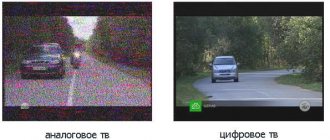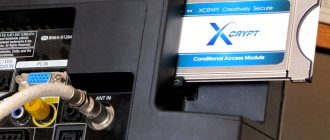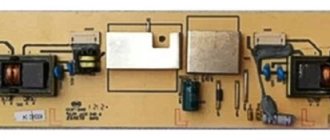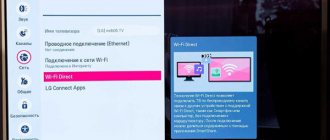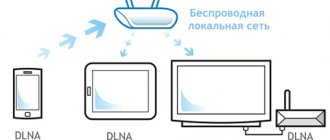Theory and history: where and why digital television came from
At the end of the last century, countries began to develop DTV - digital television, or digital television broadcasting format, which had many advantages over the analog signal that existed at that time. The abbreviation DVB itself stands for Digital Video Broadcasting.”
Common global transmission standards:
- ATSC (Advanced Television Systems Committee) is the broadcast standard in America.
- ISDB (Integrated Services Digital Broadcasting) - operates in Japan;
- DVB - created in 1991, adopted as the main format for Europe (including Russia);
The DVB family includes a group of substandards over which a TV signal can be transmitted. This is not only terrestrial television, but also cable, satellite and mobile broadcasting. The category of the standard is indicated in the title after the abbreviation. For example, DVB-C is a standard for cable television reception and transmission.
What is ATV and DTV on TV?
In Russia, in 2009, a federal program was adopted to modernize the existing television and radio broadcasting system. In January 2010, starting from the Far East, the transition to a new television broadcasting standard began. Everyone who uses a TV should be sure that with the transition to a new broadcasting standard, they will not be left without their favorite programs and programs. You need to understand whether your TV supports the new broadcast standard. To do this, let's look at what an analog and digital signal is, and what the difference is between them.
What does ATV mean?
The abbreviation can be deciphered as analog television, that is, television that uses an analog signal to transmit data. This signal is continuous and consists of three components:
- soundtrack.
- image color;
- image brightness;
The analog signal is transmitted via radio or cable. Each TV channel is assigned a carrier frequency. When you set up an ATV on your TV, the receiver sequentially scans the frequency range, reads the channel name, service information and writes them into memory.
The disadvantage of this type of transmission is susceptibility to interference. The signal is continuous and non-redundant in nature; When noise is introduced into an analog signal, it is no different from the television signal itself. The quality of reception is deteriorating. If there is a lot of this interference, they overlap each other, making the picture even worse. Artifacts, white spots or streaks appear on the screen. The ATV is greatly affected by atmospheric conditions.
Important! Another reason for switching from analog to digital is limited usage frequencies. The digital standard allows you to transmit a package of several TV channels on one frequency, freeing up bandwidth and leaving room for future increases in the number of channels.
Advantages of an ATV on TV: ease of connection. No cables or receivers are needed - just an antenna connected to the TV.
Story
The television company was founded on September 15, 1988. The name "ATV" was coined by Anatoly Malkin. He deciphered the name as “alternative television,” but Malkin’s friend and colleague Vladimir Voroshilov suggested the option “author’s television,” since in his opinion the decoding “alternative” was inappropriate.
The first program of the television company was the talk show “Press Club,” which aired in September 1989. Also in 1988-1990, ATV made stories for the Vzglyad program.
In the period from 1990 to 1992, the First Program of Central Television (later - “1st Channel of Ostankino”) on Monday evenings broadcast the channel “Author’s Television”, which was a block of programs of ATV’s own production.
From November 1991 to 1996, the company was the founder and partner of the creative association “New Studio” of the RGTRK “Ostankino”. In addition, the studio produced a weekly block of television programs, “New Studio Presents,” for Ostankino Channel One. In September 1992, ATV became the main contractor of Channel 4 Ostankino, which was placed under the authority of the New Studio.
From 1993 to 1995, together with TV and Ren-TV, it was a member of the Association of Independent Television Producers, which became the founder of ORT.
Kira Proshutinskaya
The television company repeatedly tried to create its own channel; in the late 1990s - early 2000s, it often took part in television competitions for frequencies[2]. In 2000, ATV submitted an application to broadcast on the third meter frequency in Moscow together with the VID television company. But neither VID nor ATV passed and the place was given to the existing TVC company[3]. In 2004, the company, together with Stream-TV CJSC, created the Retro-TV channel, which remained one of the owners until 2007.
In 2004-2005, ATV also produced audio books.
In 2007, the private equity fund Quadriga Capital bought a controlling stake from the founders of the studio (Kira Proshutinskaya and Anatoly Malkin) for an estimated $25 million[4].
In 2008, she received a license for satellite broadcasting and, together with AKADO-Stolitsa CJSC, created the PRO Money TV channel.
From 2009 to 2012, there was a television based on ATV, which produced such programs as “What to do?”, “Family” (“Big Family”), “Before everyone else”[5], “Dancing to Fa-Sol”, “Tea Party”, “Natural Science. Lectures + experiments”, “Theatrical Fa-Sol”, “Wife”, “Fa-Sol. Workshop”, “Homework Rescue Service”. After the divorce of founder Kira Proshutinskaya from Anatoly Malkin, the television company was closed. At the same time as Proshutinskaya, a number of employees are leaving ATV.
From 2012 to 2014, the television company’s products were produced under the name “MAG-TV” (after the first letters of the last name, first name and patronymic of the founder of the television company).
Since September 2021, ATV projects began to be published under the copyright of “IP Malkin Anatoly Grigorievich.”
What is DTV
The abbreviation stands for Digital Television - digital television, that is, using a digital or binary signal.
The advantages of such a signal:
- The digital signal is stronger and can be transmitted over longer distances.
- a package of channels can be broadcast in one signal on one frequency (a television company, having purchased a frequency, can broadcast several channels on it, dividing them by genre);
- transmission of the best quality images, atv resolution is 720x576 per inch, dtv allows you to transmit images with a resolution of up to 1920x1080;
- additional functions not available for analog TV (subtitles, the ability to record broadcasts, channel encoding);
- less susceptible to interference;
However, the digital signal is not without its drawbacks.
- Difficulty in installing over-the-air antennas. The quality of reception depends on the exact direction to the signal source.
- The need to buy a set-top box for DTV reception or a new TV.
- If there is interference in the transmission of the ATV, the image does not disappear at all, its quality deteriorates. If there is a problem with the dtv signal, the picture and sound will not be transmitted.
How does disease of the upper lobes of the right and left lungs manifest?
When the source of infection is located in the specified tissue area, usually no specific symptoms develop. The severity and severity of general manifestations depend on the size of the lesion in the right or left organ, which can be up to 4 cm in diameter (usually up to 10 mm), as well as on the body’s ability to suppress foreign microorganisms.
Nonspecific signs include: weakness, malaise, lack of appetite, headaches, low and intermittent fever.
Under other conditions, signs appear that allow you to indicate damage to the lungs and their apices:
- Pain in the supraclavicular areas, as well as in the forearm area, which intensifies at the peak of inspiration or during physical exertion. It may be intermittently cramping in nature.
- Lymphadenopathy. Usually, an increase in the cervical and axillary lymph nodes is observed, since they are closest to the source of infection and react to its presence earlier than others.
- Fever.
- Uneven breathing due to tuberculosis infection.
- Night sweats.
- Pneumonitis (may be the only symptom in older people).
Modern DTV standards
Since 1993, a planned transition to digital television broadcasting has been carried out throughout the world. Digital television standards have been adopted by the International Standardization Commission. This is what they look like at the moment.
- ATSC - format used in America and Canada
- ISDB is a digital television standard approved for Japan.
- DTMB is the standard used in China.
- DVB is a digital television standard adopted for Europe. This specification is used in Russia; we will consider it in detail; other standards are not mentioned in this review.
TV serials
| Series title | Years of manufacture | Channel | Genre |
| Rostov-papa | 2001 | NTV | drama |
| Diary of a Killer | 2003 | Russia | detective |
| Taxi driver | 2003-2006 | NTV | drama |
| Bodyguard | 2007 | Russia | thriller |
| Special group | 2007 | NTV | detective |
| Cop in law | 2008 | NTV | detective |
| Union without sex | 2008 | First channel | melodrama |
| Bus | 2008 | NTV | comedy |
| Lapushki | 2009 | First channel | melodrama |
| And in our yard | 2017 | First channel | detective |
DTV channels in Russia
In Russia, the standard adopted for European territory is used - DVB. It's short for Digital Video Broadcasting. The main body responsible for the development, implementation and standardization of DVB is the Government Commission for the Development of Television and Radio Broadcasting.
There are 4 DVB standards adopted in Russia.
- DVB-S and DVB-S2 - satellite television, for example NTV + or tricolor TV.
- DVB-T and DVB-T2 are terrestrial television that will replace all old analogue television channels. This is what we are talking about about the transition to digital broadcasting.
- DVB-C and DVB-C2 are cable television, which is now provided by telecom operators and Internet providers.
- DVB-H and DVB-SH - digital broadcasting for tablets and smartphones.
DTV standards in the world
There are no more questions about what DTV is on TV, but there is the following - how many terrestrial TV standards are there?
In order to maintain equipment compatibility around the world, it was decided to distribute broadcasting standards across different countries:
If you need a new TV, monitor, audio or household appliances, you can order them directly on the official website of a major brand - LG. It is a leader in the production and sales of electronics and household appliances Place an order
- DVB - standards of this format are used in Europe and Russia;
- ISDB - Japan works with this standard;
- ATSC - American digital terrestrial TV standard.
Further, the DVB standard has various formats designed for different concepts of use. For example:
- DVB-T, DVB-T2 - terrestrial digital TV, which can be received through an antenna via radio waves;
- DVB-S, DVB-S2 - broadcasting video data via satellite TV;
- DVB-H - distributes TV broadcasts to mobile gadgets (smartphones, tablets);
- DVB-C, DVB-C2 - digital TV transmitted via cable from a provider.
Prefix 2 in many standards means the second generation, which is distinguished by better range and noise immunity, and a larger number of broadcast channels. Including in HD quality.
How to set up DTV on TV
Analog television has been replaced by DVB-T and DVB-T2 standards. This is free terrestrial television with 20 main channels. The digital signal can be received via an antenna or a decimal cable.
How can I make sure that my TV supports the new broadcast format? First of all, it depends on the year of manufacture of the device. Most models released after 2012 have built-in support for digital channels. Information about digital format support can be found in the hardware manual or done visually. Turn on the national channel (some local channels are broadcast on ATVs due to equipment limitations). If there is an "A" next to the channel number on your TV screen, you are getting an analog signal. If not, then the signal is digital and you don’t need to configure anything else.
Important! Dtv is operating in test mode, analogue transmission is not completely disabled. Consequently, the TV may have two sets of channels that duplicate each other. They will differ in image quality and the letter A next to the channel number.
If only analog TV channels are displayed, you have two options: no channels are tuned in or the device does not support DTV mode.
- Retune channels. Enter the channel setup menu and select automatic search. The TV will rescan all frequencies and digital channels will appear in the list.
- If reconfiguring channels does not bring results, you need to purchase and connect a set-top box or receiver that supports the DVB-T2 standard.
Development of technology to meet new standards
TV manufacturers are also trying to keep up with the times. Modern devices already have built-in decoders, CAM receivers, and digital antenna outputs. In most cases, the ability to receive an analog signal remains. Another difficulty for consumers is that different regions use different digital standards. For example, American equipment is not designed to receive signals in DTV format, which can significantly complicate setup or even make it impossible.
TV repairs are 30% cheaper
than in service centers near your home
Order repairs
What is digital TV?
The simplest answer to the first part of this question is television broadcast using a digital signal. The digital signal itself is data encoded in the form of zeros and ones, transmitted “dosed” in the form of blocks (for comparison, the analog signal is continuous). However, it cannot be said that analog signals are not used in the digital television broadcasting system. In fact, without them nothing would work at all. An analog signal is original (if we consider terrestrial television), which is simply encoded into zeros and ones by special equipment before being sent. But we will not take into account all this technical side of the moment.
Due to the fact that “digital” is significantly different from “analog”, its reception also requires a special device - a digital-to-analog converter called a “TV tuner” or simply a “TV set-top box”. This, in turn, converts (decodes) the digital signal into a format that is “readable” for television. We will definitely return to this issue a little later.
Decoding the abbreviation
The letters “DTV” indicate the “Digital Television Transition” technology, which translates as “Digital Terrestrial Television”. For a TV to work with this technology, its receiver must support DTV, accept a signal of this format and output video and an audio track. The receiver is usually an external receiver, but modern TV models are equipped with such a receiver by default.
The transmitted signal is encoded in MPEG digital format and presented as binary code. The basis of its popularity is that the signal is not affected by weather conditions (as was previously the case with analog). Even if there is rainy weather or strong wind outside, the TV will not lose signal.
Digital TV parameters in Russia
Digital television systems operate in accordance with television broadcasting standards. There are a few. For reference, here are descriptions of the 4 most common standards:
- DVB-T and DVB-T2. These are European broadcast standards of the first and second generation, respectively. In Russia, as in most countries of the world, the DVB-T2 standard is used.
- ATSC. American digital television standard. Used in the USA, Canada, South Korea and some Latin American countries.
- ISDB. Japanese standard "numbers". In addition to Japan itself, it is also used in most countries in Central and South America, some countries in Asia and Africa.
- DTMB. This is the youngest Chinese digital broadcasting standard. In addition to China, the standard has also been adopted in Pakistan, Laos, Cambodia, Cuba and some other countries. According to the Chinese themselves, DTMB surpasses all three previous standards in all respects.
Regarding the main parameters of the European DVB-T2 standard used in Russia:
- Resolution of the transmitted video image: 720×576 pixels (i.e. video in SD quality).
- Frequency channels reserved for transmission: 6... 12 for the metric scale and 21... 60 for the decimal scale.
- Transmission is carried out on metric (MV / HF) and decimeter (UHF / UHF) radio frequencies in the ranges 174... 230 MHz and 470... 790 MHz, respectively.
Free digital TV channels available in Russia
Most digital TV channels broadcast in Russia today are paid. Only 20 of them are available for free. They all make up a list of “all mandatory all-Russian TV channels.” These include: Channel One, Russia-1, Russia-24, Russia-K, Match TV, NTV, TV Center, Carousel, OTR, Channel Five, Muz-TV, REN TV, Spas, TNT, STS, Domashny, Mir , Star, Friday! and TV-3.
The listed TV channels are broadcast throughout the Russian Federation. To view them, you do not have to enter into an agreement with anyone. All you need is a TV receiver that supports digital television (or equipped with a set-top box), and any UHF or all-wave antenna (even homemade) (and may not be needed).
Many Internet service providers today offer free access to many paid digital channels when you sign an Internet service contract. However, to watch these channels, you do not use an antenna, but a computer network cable that connects to a TV or set-top box. These TV channels can often be accessed from a dedicated mobile application or the provider's website.
Features of searching and tuning channels without a remote control
Don't panic or get upset if your TV remote control gets lost or stops working. You can cope with the situation and configure the equipment using control buttons, the functions of which are described in detail in the instructions for the equipment.
When setting up a TV without a remote control, consider the following nuances:
- The key is not available on all devices. Sometimes, in order to get into the settings, you need to simultaneously press the buttons that control the volume;
- To confirm the actions taken, you can use the “OK”, “” or “Vol+” buttons;
- On Sony brand TVs, you can start automatic search and tuning of channels by long pressing the “” button;
- Philips TVs cannot be set up without a remote control.
In recent years, Russians have almost completely abandoned conventional antennas, giving preference to more modern and high-tech receivers - special digital set-top boxes that receive signals from a satellite or via the Internet. Such devices operate similarly to smartphones or tablets: they have an operating shell (Android) installed, in which settings and work with channels were carried out using mobile applications. Users can download the necessary software from the PlayMarket store.
Advantages and disadvantages of digital TV
Digital television has many advantages over analogue television, although there are also some disadvantages. The positive qualities of digital TV include:
- Possibility of transmission on the same radio frequencies (also thanks to multiplexing) and other advantages.
- Wide range of possibilities for editing TV programs broadcast in real time (for example, overlaying 3D graphics).
- Possibility of broadcasting several TV channels in the same frequency range (signal multiplexing). For reference: thanks to multiplexing, it was possible to free up many radio frequencies that were previously allocated for broadcasting some TV channels. Now they are intended for use in building cellular networks and for other purposes.
- Ability to change audio tracks on the fly. This service is usually provided to viewers of pay TV channels and is most often used to change the translation language of films, TV series, etc.
- Creation of interactive television systems in which the viewer can be provided with various, “Recording TV programs” (using camera equipment) and others.
- The ability to transmit additional information along with the TV signal (for example, the names of films or TV shows).
- High quality picture and sound, incomparable to the quality of analog television.
- Increased noise immunity with lower power consumption of signal transmitters.
Their disadvantages of digital TV stand out:
- For owners of old TVs, it is necessary to purchase a set-top box. However, they are not very expensive.
- Low resistance to electromagnetic fields is observed during a thunderstorm. If the TV receiver is located a significant distance from the transmitter, the signal may be completely cut off during a thunderstorm.
- Shorter digital signal transmission distance (when comparing analog and digital transmitters of the same power). Consequently, building a digital transmission network requires the use of more transmission devices and, as a result, greater investment.
- If the signal level is insufficient, the resulting image seems to “break into pieces” (part of the image is not visible completely or partially), “freezes” (and after the “fall”, the video / audio stream that was not received is lost, which is why the TV program looks like would fast forward a few seconds) or disappear completely. In the case of analog TV, when the signal level is weak, visual interference occurs, sound deteriorates, and so on, but the meaning of what is happening on the screen remains clear.
Let us note one more controversial point (whether it’s a minus or not is up to you to decide). To fully enjoy the quality of digital TV, a regular TV will not work. Old TVs (regardless of the characteristics of the set-top box) simply cannot display the video image in the quality in which the broadcast is being carried out. But in any case, the image quality will be no worse than “analog”.
Complications
Complications of focal pulmonary tuberculosis are extremely rare if the disease reaches a severe stage. This happens due to lack of proper treatment.
Possible complications:
- hemoptysis;
- pneumothorax;
- inflammation of the pleura;
- pulmonary hemorrhage;
- progressive course of the disease.
To prevent such health problems, annual fluorography should be performed, as well as other methods of preventing infectious disease.
How to start watching digital TV?
It has been mentioned more than once that watching digital television requires specially designed equipment. The easiest way to start watching “digital” is to buy a TV that supports the DVB-T2 television broadcasting standard. It is clear that many people cannot afford a new TV or simply do not need it. Fortunately, to watch digital TV channels you can buy a set-top box (tuner), the price of which is much lower than the cost of a new TV. In addition to the TV receiver itself, you may also need an antenna. This is especially true for those who live a considerable distance from the nearest TV transmitter.
How can I check if my TV is ready to switch to digital? And what if not?
you need to activate any of the central channels (Channel One, Russia 1, Channel Five, STS, TNT, NTV and others) and carefully look at the TV screen. If you see the letter "A" next to the channel logo, it means you have an analog broadcast.
If you have a modern TV made after 2012, chances are it supports the DVB-T2 digital standard, you just need to set it up for the new broadcast. If your TV does not support this standard, you can connect a DVB-T2 digital decoder.
Setting up channels on older TV models
If desired, you can watch digital channels on an old TV; all you need to do is manually configure the TV receiver and connect a DVB-T2 set-top box to it. Perhaps the only drawback of outdated TV models is the small amount of memory for saving frequently watched channels; most often, you can add no more than six positions to this list.
To search for and configure older TV models, you can use not only remote controls, but also physical control buttons on the TV itself.
What are multiplexes
Analogue transmission is carried out by each channel at a different frequency. With the development of digital television in Russia, streaming has become possible - the transmission of several channels on the same frequency.
All TV channels sent from several television centers on the same frequency are combined into a multiplex on a repeater, which already distributes packets to receivers. This transmission technology allows you to solve a number of problems:
- Organization. Repeaters operating at a single frequency have a simpler design, unlike multi-frequency analog towers. They spread faster, which is why television spreads faster.
- Bureaucracy. For analogue broadcasting, each television channel had to obtain a license that allowed it to occupy certain frequencies of digital channels in each region. With the advent of streaming, this need has disappeared, so digital channels are expanding their presence much faster.
- All programs are on the same TV channel, which is easy to find using automatic tuning. The user does not need to physically change the TVC to change the broadcast program.
Today there are two active multiplexes and one multiplex test. Each of them is at a certain stage of work and has a different geographical coverage.
This is because a specific multiplex requires a separate tower to broadcast, and each of the digital channel packages appeared at a different time. While the first multiplex has existed for more than five years, the second has appeared recently, and the third has not yet been officially launched.
First multiplex (RTRS-1)
What is multiplex on television? This is a broadcast from several television centers in a single wireless signal. Includes the first 10 channels to start digital broadcasting. Their composition and broadcast period are regulated by Roskomnadzor, i.e. they cannot be changed.
The first list of multiplexes (RTRS-1) includes 10 channels, most of which are federal level programs, also known as analogue broadcasts:
- First,
- Russia 1,
- Match TV,
- NTV,
- Channel 5 (St. Petersburg),
- Russia-K,
- Russia 24,
- Carousel,
- OTP,
- TVC (TV Center).
In addition, three radio channels can be received from RTRS-1 repeaters: Vesti FM, Mayak, Radio Russia. Now the channels of the first digital television multiplex work everywhere in Russia, regardless of the population of the area and the distance from the tower.
Second multiplex (RTRS-2)
Includes 2nd Digital Streaming Channel Pack. Like the first, the second multiplex includes 10 programs of federal and regional significance.
It included:
- REN TV,
- SAVED,
- ST,
- House,
- TV3,
- Friday!,
- Star
- WORLD,
- TNT,
- Muz TV.
The second digital television multiplex was launched recently and is not distributed throughout the country. Its transmission requires independent repeaters, which take time to distribute and equip.
When the 2nd multiplex is turned on in the area, you can find out on the map: towers under construction or planned for deployment are marked with a gray icon. The second package does not contain radio broadcasts.
Third multiplex (RTRS-3)
It is currently in trial mode. Broadcasting is scheduled to begin in 2021. Unlike the first two, the third multiplex includes more than 40 federal and regional channels broadcasting at different times. In terms of the volume of digital broadcasting, the entire television package is comparable to the daily operation of 10 channels.
The third multiplex is now available only to residents of the Moscow region. The broadcast is already underway from the Ostankino Tower. There are no RTRS-3 repeaters, and you can only receive a digital signal with the third package directly from the television center.
Important! The package of channels currently on air is not final. This may change over time.
Broadcast frequencies
Each region has its own broadcast frequency for each digital multiplex. This is due to the parallel development of regional channels, which already occupied part of the frequency range even before the installation of the repeater.
Below is a table with broadcast frequency and digital TV channel (TVK) for Moscow and some large cities.
| Fly | Saint Petersburg | Ekaterinburg | N. Novgorod | Rostov-on-Don | |
| 1st multiplex | 546 MHz (30 TVK) | 586 MHz (35 TVK) | 674 MHz (46 TVK) | 530 MHz (28 TVK) | 602 MHz (37 TVK) |
| 2nd multiplex | 498 MHz (24 TVK) | 666 MHz (45 TVK) | 786 MHz (60 TVK) | 730 MHz (53 TVK) | 610 MHz (38 TVK) |
| 3rd multiplex | 578 MHz (34 TVK) | – | – | – | – |
You can find out the broadcast frequency and TV channel for your city and region on the website rtrs.rf. At the moment, it is unknown when the third multiplex will be launched in the regions.
Notes
- ATV history
- TV-6 and six. Kommersant-Vlast (January 29, 2002). Retrieved June 4, 2021.
- TVC will broadcast on channel three. Lenta.ru (July 6, 2000). Retrieved January 10, 2013. Archived January 19, 2013.
- TV studio "ATV" (Author's Television) has changed its owner
- Aroseva's program disappeared from the air along with the smog. Komsomolskaya Pravda (August 24, 2010).
- New Monday. ATV.
- IN SEARCH OF THE LOST UNION. Novaya Gazeta (July 9, 2001).
- DIALOGICAL CHAIN.
Andrey Maksimov celebrates the 1500th episode of Night Flight. Novaya Gazeta (December 1, 2005). - ANDREY MASIMOV: “NIGHT FLIGHT”.
Labor (March 23, 2002). - Why was Andrei Maksimov’s “Night Flight” closed on the “Culture” channel?
Komsomolskaya Pravda (April 1, 2009). - Interview with Grigory Yavlinsky on the “People Want to Know” program. Grigory Yavlinsky (December 16, 1999). Archived March 16, 2005.
- PUBLIC SEARCH FOR THE “CONSCIENCE OF THE NATION”. Labor (October 23, 2003).
- TV moguls slow down TV programs
- Alexey Begak will be “Country Duty” together with Mikhail Zhvanetsky.
Inter (May 3, 2018). - TVC talks about computers and their creators. PC Week/RE (May 25, 2003).
- Glimpses of intelligence. Izvestia (August 24, 2003).
- DISPUTE OF PHILOSOPHYING SUBJECTS. Ogonyok (February 23, 2004).
- Ernst removed Aroseva from the air. Interlocutor (September 13, 2010).
General setup instructions
Before organizing digital television, you need to check the signal level and the distance of the repeaters from your place of residence. To do this, you need to go to the website map.rtrs.rf and enter the location (if automatic detection is enabled in the browser, the resource will select it independently).
A map will open showing nearby two-color towers:
- Red. RTRS-2, second multiplex.
- Blue RTRS-1, the first multiplex.
After clicking on the icon of a specific tower, the coverage area will open to which the signal and the operator servicing it are transmitted. If your home area is completely covered, you can buy an antenna inexpensively. In case of partial coverage, you will need a powerful receiver with a 12 dB amplifier.
Important. The name of the service operator can be useful in case of no transmission, so they can be contacted directly.
Required equipment for viewing
After making sure that digital TV is available in your area of residence, you can proceed to selecting equipment.
For technical support of digital television reception, two devices are required:
- Recipient. The antenna power is selected taking into account the distance of the repeater. It is recommended to buy in specialized stores; consultants will advise you on a suitable receiver. At the same time, they will help you learn and better understand how digital works.
- Signal decoder. It serves as a TV tuner for all modern TVs. Otherwise you will need a digital receiver. In this case, it is recommended to buy a universal set-top box, because it can be useful when connecting satellite or cable television and it is better to save money for the future. They are not much more expensive than simple digital receivers.
After purchasing the equipment, you can start connecting.
How is digital television different from analogue?
But this is not the only reason for the country's transition to the digital broadcasting standard. The main differences from an analog signal are as follows:
- The analog signal of this channel requires transmission on a dedicated terrestrial frequency, which means that each of them needs its own personal range. For this reason, the number of available channels is limited, since it is physically impossible to allocate separate bandwidth to all television stations. In digital television, an entire (multiplex) package of 10 channels is broadcast on one frequency. That is, to replace the analogue one, you can start showing a dozen digital assets, and this with a significant increase in the quality of the broadcast.
- Digital data packets are more resistant to interference that affects them during transmission. Thanks to this, the level of distortion of video and audio information transmitted via radio waves is significantly reduced.
- The ability to obtain high-quality images with maximum accuracy, detail, brightness and color rendition. The image in this case is not inferior in its characteristics to the image reproduced on digital media and transmitted via cable. Previously, such capabilities were not available for live TV broadcasts.
As you can see, the transition to digital is beneficial not only to us, ordinary users who receive a bright picture on the TV screen, but also to television companies, which can significantly expand the list of channels provided.
Image quality
The quality of the television image of analogue TV is largely determined by the TV standard. The frame that provides analog transmission includes 625 lines with an aspect ratio of 4 × 3. Thus, the old kinescope shows an image from television lines, while a digital image consists of pixels.
Image with analog signal
With poor reception and interference, the TV will “snow” and hiss, not giving the viewer any image or sound. In an attempt to remedy this situation, cable television was once introduced.
Image on digital signal
Other options
Despite the rapid development of electronic technology and the advantages of digital technology over analog, there are still areas in which analog technology is necessary, such as professional audio processing. But even though the original recording may be as good as the number, after editing and copying it will inevitably be noisy.
Here are a number of basic operations that can be performed with an analog stream:
- development and modification of the parameters of its physical quantities.
- multiplication, sum and logarithm;
- modulation, aimed at reducing its susceptibility to interference, and demodulation;
- frequency filtering and processing;
- strengthening and weakening;
Setting up satellite channels
In general, setting up satellite channels is not difficult:
- We connect the TV and receiver using a special cable. We switch the TV to monitor mode.
- Using the remote control we set the satellite settings.
- In the menu we start scanning the satellite. The best option would be to use an automatic search, which will carry out all the necessary actions without user intervention.
- We edit the list of saved channels, remove from it TV channels that most likely will not be viewed by viewers;
When using satellite television, remember that deteriorating picture or sound may be caused by rain, wind or thunderstorms, which negatively affect reception conditions.
How is digital television different from cable?
Let’s immediately answer the most frequently asked question: is cable television digital or analogue? The wording itself is not entirely correct. The thing is, it all depends on the provider you use. Technically, it can be either analog or digital, since it plays virtually no role when transmitting a signal over cable lines.
But note that most companies now provide access to digital cable packages. You can clarify the question by contacting the hotline or on the official website of the provider.
If we compare digital terrestrial and cable television, there is no difference in the quality of the image received on the TV screen. The data transmission technology is the same, only in the first case the distribution occurs through the use of a radio channel, in the second - through the existing wired network. In both cases, a tuner is required to decode the received signal.
For terrestrial television - DBVT2, for cable - DBVC. Please pay attention to the supported format when purchasing a set-top box; they are not interchangeable. In addition, more modern TV models are already equipped with similar receivers, and these may be devices that support several formats.
Now a few words about the differences:
- Such high costs are not necessary to connect to digital terrestrial television. Television will receive channels both from a collective antenna and from a personal antenna operating in the UHF range. Purchasing a new one may only be requested in rare cases. The only expense for older TV owners is the need to purchase an additional set-top box. Such a device is inexpensive, and there is also a cost compensation program for certain categories of socially vulnerable citizens of the Russian Federation.
- Connecting cable TV requires laying a large number of networks. If in urban conditions this is not a problem, then most apartment buildings are already equipped with such communications, then in rural areas, in small towns with a predominance of private low-rise buildings, laying cables will be expensive. This is due to long distances, so the price depends on the cost of the cable and maintenance during further operations. A digital TV support service in your area can help you determine the exact cost of connection.
- Cable TV usually provides access to several channels, depending on the package chosen (up to 200 or more). A maximum of 30 channels are available for terrestrial digital broadcasting. At the same time, the practice of using cable networks has shown that the average user regularly watches no more than 3-4 dozen channels.
- Despite such a big difference in quantity, we note the decisive factor. To use cable television, you will pay a monthly subscription fee, the amount of which is determined directly by the provider. And access to digital terrestrial channels is provided free of charge within three multiplexes (about 30 channels in a reliable reception area). In addition, they include the most popular federal and regional information and entertainment channels.
As you can see, cable television can provide a wider range of services, but you will have to pay extra for it. When choosing digital terrestrial television, this need will not arise.
Choosing correctly between ATV and UTV
Utility ATVs
Utilitarian cars are designed for work rather than fun. They will help you cope with the transportation of cargo, carry out work on your plot or farm, and deliver the necessary equipment to the tent camp. Utility ATVs differ from sport ATVs with stiffer suspension, full underbody protection, cargo frames, tow hooks and four-stroke engines. Such cars are usually larger than sports cars, and have a massive plastic body that protects the driver well from dirt and debris off-road. Another difference from sport ATVs is the use of a more reliable and durable driveshaft instead of a chain drive. To carry heavy loads, most utility ATVs have a low gear that provides maximum torque. Remember that if you plan to actively use the ATV for cargo transportation and farm work, it is better to give preference to liquid-cooled motors. Although the main purpose of utilitarian ATVs is work, they can also be used for fun off-road adventures. Moreover, it will be much easier for newcomers to the sport to learn how to drive just such ATVs, because they are heavier and more massive than their counterparts, which means motorists will feel more comfortable driving such cars. Overall, utilitarian ATVs account for about 80% of the off-road vehicle market.
Sports ATVs
These are the lightest and fastest of all ATVs. Their two-stroke or four-stroke engines are usually finely tuned for maximum speed. The engines of sports ATVs are paired with a manual 5- or 6-speed transmission, which most often also has a reverse gear. These cars develop the most power in high gears. Weight is of the utmost importance on sport ATVs, so all non-essential parts are kept to a minimum or completely absent so as not to interfere with the machine's ability to perform jumps and tricks. The plastic parts of the body are also modest in size, so drivers should be prepared to get dirty while driving such an ATV. To learn how to drive a sports ATV, you will need a little practice and the ability to make the car move where it should due to the driver’s body movements. If you love high speed and want to try your hand at jumping, a sport quad bike will be the best choice for you.
Oleg Kolomchenko
December 31, 2011 at 07:22 pm
What is the difference between digital terrestrial television and satellite
And in this case, the differences are related to the technical scheme of digital signal transmission during transmission. If for terrestrial television broadcasting a whole network of ground-based repeaters is used, then satellite broadcasting is based on working with devices that move in orbit close to the Earth.
As with cable, satellite packages include an expanded list of channels. In addition, you yourself can choose those that are at your disposal from different operators. But you have to pay for everything. The minimum cost of using satellite channel packages already exceeds 100-200 rubles per month, which is a decent amount for a year. In addition, for reliable signal reception it is necessary to purchase a satellite dish and an additional receiver; compared to the purchase of a set-top box for terrestrial TV, costs increase by an order of magnitude
Users note that with a small diameter satellite dish, there is a high probability of signal distortion under adverse weather conditions.
Based on this, digital terrestrial television has a slightly smaller variety of channels, but does not require the costs associated with subscription fees for access to information and entertainment resources.
Content:
Before you can enjoy watching your favorite movies or TV shows, you need to configure the channels on your device. Setting up a TV is a rather complex and responsible procedure, which, firstly, includes searching for channels, and secondly, it will allow you to remove unnecessary things and rank the list by frequency of views.
This procedure is especially relevant in our time, when the list of channels is regularly updated, which leads to failure of all previously specified settings. When working with cable and satellite television, the task of setting up a TV becomes more complicated.
What is the difference between digital television and interactive television?
And this comparison is not entirely correct. Indeed, interactive television today is digital television broadcasting, providing access to a wider range of services. Using this option, you can watch only what interests you. Find out what provides access to interactive systems:
- Access to remote cinemas with an extensive movie library.
- Additional entertainment resources from online games to karaoke.
- The ability to control the viewing of broadcast programs: pause, record, rewind to the moment of interest. In addition, in some systems such manipulations can be performed even with programs that were broadcast several days ago.
- Access to other information resources based on the teletext principle: exchange rates and weather forecasts, stock and economic data.
By the way, if you still don’t know what antenna is needed to receive the figure, then all the details are in this article. And here we will show you how to find out if your TV is receiving a digital signal.
But the image and sound quality itself will remain the same as that of digital terrestrial television. You'll still have to pay extra just to access interactive features.
Setting up Smart TV on modern TVs
We live in the era of “smart” technology. Today, refrigerators, washing machines, dishwashers, and televisions have their own intelligence. The Smart TV feature is an innovative technology that is completely dependent on the Internet. It allows you to convert an ordinary TV into a full-fledged computer, with which you can make purchases in online stores, view news on information resources and enjoy your favorite programs in high quality.
Leading home appliance manufacturers create full-fledged operating shells for their smart TVs, while many other brands use Android, Linux and Windows for these purposes. You can configure TV channels on Smart TV using special applications.
Comparison of standards
it is necessary to understand that each standard requires certain equipment and conditions, besides, only regular terrestrial television is free.
| DVB-T2 | DVB-C2 | DVB-S2 | IPTV | |
| Monthly payment | it's free | 200 rub | 200 rub | 300 rub |
| Necessary equipment | TV with built-in tuner or digital decoder, UHF antenna | TV with built-in tuner or receiver, CAM module with access card | TV with built-in tuner or receiver, CAM module with access card, satellite dish | SMART TV, decoder or computer |
| Cost of equipment | from 0 rub, immediately | 1500-2500 rubles, rent or installments | 1500-8000 rubles, daily or in installments | 1500-11000 rub., immediately |
| Number of channels | 20-30 | 50–150 | 50–150 | is not limited |
| Maximum resolution available | SDTV 960×540 pixels | Full HD 1920×1080 pixels | Full HD 1920×1080 pixels | Full HD 1920×1080 pixels |
| Prevalence | 98% of the territory of the Russian Federation, except for remote and hard-to-reach places | not available in small settlements where it is not profitable to lay cable | 100% of the territory of the Russian Federation | requires fast internet, so it is not available in remote regions |
How does TVEL work?
Enriched uranium falls into the hands of engineers, but this is still used for nuclear fuel. The production of this fuel is akin to powder metallurgy. The powdered metal (or its chemical compounds) is pressed into small tablets about a centimeter in diameter.
Products made from uranium metal are better suited to withstand the hellish conditions inside a reactor, but the pure element is very expensive to produce. Uranium dioxide is much cheaper, but so that it does not crumble under enormous pressure and heat, it has to be baked under enormous pressure at a temperature of more than 1000 °C.
A TVEL is a set of such washers about 2-4 meters long, placed in a tube made of steel or iron-molybdenum alloys. The fuel rods themselves are assembled into a bundle of several tens or even hundreds. This set is called a fuel assembly (FA).
FAs are installed directly in the heart of a nuclear reactor. In one reactor their number can reach several hundred. As uranium decays, fuel rods lose their ability to produce heat, then they are replaced. But one kilogram of technical uranium, enriched to a content of 235 isotope 4%, during its life in a nuclear reactor manages to produce the same amount of energy as would be obtained by burning 300 standard two-hundred-liter barrels of heating oil.
